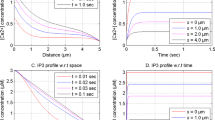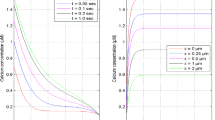Abstract
Calcium (\({\text {Ca}}^{2+}\)) signaling is the secondary signaling processes which have been one of the most vital intracellular signaling mechanisms. Over recent decades, this signaling process has been studied a lot in various cells to understand its mechanisms and also cure of various health hazards. In this paper, an attempt has been made to propose a model for coupled dynamics of \({\text {Ca}}^{2+}\) and inositol 1,4,5-trisphosphate (\({\text {IP}}_3\)) in cardiac myocyte for a better understanding of the dependence of \({\text {Ca}}^{2+}\) signaling on other chemical ions such as \({\text {IP}}_3\) ions. The parameters such as influx, outflux, diffusion coefficient, SERCA pump, and Leak have been incorporated into the model and the finite differences scheme has been employed for the solution of the problem. The numerical results have been used to study the interdependence of \({\text {Ca}}^{2+}\) and \({\text {IP}}_3\) in the cardiac myocyte. It is observed that this interdependence is quite significantly affected by all these parameters except Leak. Also, the relationship between \({\text {Ca}}^{2+}\) and \({\text {IP}}_3\) dynamics is found to be non-linear. Such realistic models can be useful to generate the information of these dynamics in cardiac cells which can be useful for developing protocols for diagnosis and treatment of heart diseases like abnormal calcium signaling due to mutation of calsequestrin which results in sudden cardiac death and cardiomyopathy that affects the squeezing of the heart muscle.













Similar content being viewed by others
References
Adkins CE, Taylor CW (1999) Lateral inhibition of inositol \(1, 4, 5-\)trisphosphate receptors by cytosolic \(Ca^{2+}\). Curr Biol 9(19):1115–1118
Allbritton NL, Meyer T, Stryer L (1992) Range of messenger action of calcium ion and inositol \(1, 4, 5-\)trisphosphate. Science 258(August):1812–1814
Alonso-Carbajo L, Kecskes M, Jacobs G, Pironet A, Syam N, Talavera K, Vennekens R (2017) Muscling in on TRP channels in vascular smooth muscle cells and cardiomyocytes. Cell Calcium 66:48–61
Backx PH, De Tombe PP, Van Deen JH, Mulder BJ, Ter Keurs HE (1989) A model of propagating calcium-induced calcium release mediated by calcium diffusion. J Gen Physiol 93(5):963–977
Bers DM (2000) Calcium fluxes involved in control of cardiac myocyte contraction. Circ Res 87(4):275–281
Brown SA, Morgan F, Watras J, Loew LM (2008) Analysis of phosphatidylinositol-4,5-bisphosphate signaling in cerebellar Purkinje spines. Biophys J 95(4):1795–1812
Cooling M, Hunter P, Crampin EJ (2007) Modeling hypertrophic \(IP_3\) transients in the cardiac myocyte. Biophys J 93(10):3421–3433
Cui C, Merritt R, Fu L, Pan Z (2017) Targeting calcium signaling in cancer therapy. Acta Pharmaceutica Sinica B 7:3–17
Dawson AP (1997) Calcium signalling: how do \(IP_3\) receptors work? Curr Biol 7(9):R544–R547
De Young GW, Keizer J (1992) A single-pool inositol \(1, 4, 5-\)trisphosphate-receptor-based model for agonist-stimulated oscillations in \(Ca^{2+}\) concentration. Proc Natl Acad Sci 89(20):9895–9899
Dupont G, Goldbeter A (1993) One-pool model for \(Ca^{2+}\) oscillations involving \(Ca^{2+}\) and inositol \(1, 4, 5-\)trisphosphate as co-agonists for \(Ca^{2+}\) release. Cell Calcium 14(4):311–322
Falcke M (2003) Buffers and oscillations in intracellular \(Ca^{2+}\) dynamics. Biophys J 84(1):28–41
Fink CC, Slepchenko B, Moraru II, Watras J, Schaff JC, Loew LM (2000) An image-based model of calcium waves in differentiated neuroblastoma cells. Biophys J 79(1):163–183
Goonasekera SA, Hammer K, Auger-Messier M, Bodi I, Chen X, Zhang H, Reiken S, Elrod JW, Correll RN, York AJ et al (2012) Decreased cardiac L-type \(Ca^{2+}\) channel activity induces hypertrophy and heart failure in mice. J Clin Investig 122(1):280
Hamam Y, Pecker F, Rocaries F, Lorino H, Pavoine C, Natowicz R (2000) Identification and modeling of calcium dynamics in cardiac myocytes. Simul Pract Theory 8(1):3–15
Handy G, Taheri M, White JA, Borisyuk A (2017) Mathematical investigation of \(IP_3\)-dependent calcium dynamics in astrocytes. J Comput Neurosci 42(3):257–273
Harootunian A, Kao J, Paranjape S, Tsien R (1991) Generation of calcium oscillations in fibroblasts by positive feedback between calcium and \(IP_3\). Science 251:75–78
Higgins ER, Cannell MB, Sneyd J (2006) A buffering SERCA pump in models of calcium dynamics. Biophys J 91(1):151–163
Hohendanner F, McCulloch AD, Blatter LA, Michailova AP (2014) Calcium and \(IP_3\) dynamics in cardiac myocytes: experimental and computational perspectives and approaches. Front Pharmacol 5:1–15
Hund TJ, Ziman AP, Lederer WJ, Mohler PJ (2008) The cardiac \(IP_3\) receptor: Uncovering the role of “the other” calcium-release channel. J Mol Cell Cardiol 45:159–161
Jha A, Adlakha N (2014) Analytical solution of two dimensional unsteady state problem of calcium diffusion in a neuron cell. J Med Imaging Health Inf 4(4):547–553
Jha A, Adlakha N (2014) Finite element model to study the effect of exogenous buffer on calcium dynamics in dendritic spines. Int J Model Simul Sci Comput 5(02):1350027
Jha A, Adlakha N (2015) Two-dimensional finite element model to study unsteady state \(Ca^{2+}\) diffusion in neuron involving ER, LEAK and SERCA. Int J Biomath 8(01):1550002
Jha BK, Adlakha N, Mehta MN (2011) Finite volume model to study the effect of ER flux on cytosolic calcium distribution in astrocytes. J Comput 3(1):74–80
Jha B, Neeru A, Mehta M (2012) Analytic solution of two dimensional advection diffusion equation arising in cytosolic calcium concentration distribution. Int Math Forum 7:135–144
Jha BK, Adlakha N, Mehta MN (2013) Two-dimensional finite element model to study calcium distribution in astrocytes in presence of VGCC and excess buffer. Int J Model Simul Sci Comput 4(02):1250030
Jha A, Adlakha N, Jha BK (2016) Finite element model to study effect of \(Na^+ - Ca^{2+}\) exchangers and source geometry on calcium dynamics in a neuron cell. J Mech Med Biol 16(02):1650018
Kotwani M (2015) Modeling and simulation of calcium dynamics in fibroblast cell involving excess buffer approximation (EBA), ER flux and SERCA pump. Proc Comput Sci 49(1):347–355
Kotwani M, Adlakha N (2017) Modeling of endoplasmic reticulum and plasma membrane \(Ca^{2+}\) uptake and release fluxes with excess buffer approximation (EBA) in fibroblast cell. Int J Comput Mater Sci Eng 6(01):1750004
Kotwani M, Adlakha N, Mehta MN (2012) Numerical model to study calcium diffusion in fibroblasts cell for one dimensional unsteady state case. Appl Math Sci 6(102):5063–5072
Kotwani M, Adlakha N, Mehta MN (2014) Finite element model to study the effect of buffers, source amplitude and source geometry on spatio-temporal calcium distribution in fibroblast cell. J Med Imaging Health Inf 4(6):840–847
Luo C-H, Rudy Y (1994a) A dynamic model of the cardiac ventricular action potential. I. Simulations of ionic currents and concentration changes. Circ Res 74(6):1071–1096
Luo C-H, Rudy Y (1994b) A dynamic model of the cardiac ventricular action potential. II. Afterdepolarizations, triggered activity, and potentiation. Circ Res 74(6):1097–1113
Manhas N, Pardasani KR (2014) Mathematical model to study \(IP_3\) dynamics dependent calcium oscillations in pancreatic acinar cells. J Med Imaging Health Inf 4(6):874–880
Manhas N, Pardasani KR (2014) Modelling mechanism of calcium oscillations in pancreatic acinar cells. J Bioenerg Biomembr 46(5):403–420
Manhas N, Sneyd J, Pardasani KR (2014) Modelling the transition from simple to complex \(Ca^{2+}\) oscillations in pancreatic acinar cells. J Biosci 39(3):463–484
Michailova A, DelPrincipe F, Egger M, Niggli E (2002) Spatiotemporal features of \(Ca^{2+}\) buffering and diffusion in atrial cardiac myocytes with inhibited sarcoplasmic reticulum. Biophys J 83:3134–3151
Monteith GR, McAndrew D, Faddy HM, Roberts-Thomson SJ (2007) Calcium and cancer: targeting \(Ca^{2+}\) transport. Nat Rev Cancer 7(7):519–530
Naik PA, Pardasani KR (2015) One dimensional finite element model to study calcium distribution in oocytes in presence of VGCC, RyR and buffers. J Med Imaging Health Inf 5(3):471–476
Naik PA, Pardasani KR (2018) 2D finite-element analysis of calcium distribution in oocytes. Netw Model Anal Health Inf Bioinform 7(1):10
Panday S, Pardasani KR (2013) Finite element model to study effect of advection diffusion and \(Na^+/Ca^{2+}\) exchanger on \(Ca^{2+}\) distribution in Oocytes. J Med Imaging Health Inf 3(3):374–379
Panday S, Pardasani KR (2014) Finite element model to study the mechanics of calcium regulation in oocyte. J Mech Med Biol 14(02):1450022
Pathak KB, Adlakha N (2015) Finite element model to study calcium signalling in cardiac myocytes involving pump, leak and excess buffer. J Med Imaging Health Infs 5(4):683–688
Pathak KB, Adlakha N (2015) Finite element model to study one dimensional calcium dynamics in cardiac myocytes. J Multiscale Model 6(02):1550003
Pathak K, Adlakha N (2017) Finite element simulation of advection diffusion of calcium in myocytes involving influx and excess buffer. Adv Comput Sci Technol 10(1):11–23
Politi A, Gaspers LD, Thomas AP, Höfer T (2006) Models of \(IP_3\) and \(Ca^{2+}\) oscillations: frequency encoding and identification of underlying feedbacks. Biophys J 90(9):3120–3133
Przybytkowski E, Behrendt M, Dubois D, Maysinger D (2009) Nanoparticles can induce changes in the intracellular metabolism of lipids without compromising cellular viability. FEBS J 276:6204–6217
Rizaner N, Onkal R, Fraser SP, Pristerá A, Okuse K, Djamgoz MB (2016) Intracellular calcium oscillations in strongly metastatic human breast and prostate cancer cells: control by voltage-gated sodium channel activity. Eur Biophys J 45(7):735–748
Shannon TR, Wang F, Puglisi J, Weber C, Bers DM (2004) A mathematical treatment of integrated Ca dynamics within the ventricular myocyte. Biophys J 87(5):3351–3371
Singh N, Adlakha N (2019) Nonlinear dynamic modeling of 2-dimensional interdependent calcium and inositol 1,4,5-trisphosphate in cardiac myocyte. Math Biol Bioinf 14:290–305
Smith GD, Keizer JE, Stern MD, Lederer WJ, Cheng H (1998) A simple numerical model of calcium spark formation and detection in cardiac myocytes. Biophys J 75(1):15–32
Sneyd J (1994) Calcium buffering and diffusion: on the resolution of an outstanding problem. Biophys J 67(1):4
Sneyd J, Sherratt J (1997) On the propagation of calcium waves in an inhomogeneous medium. SIAM J Appl Math 57(1):73–94
Stewart BD, Scott CE, McCoy TP, Yin G, Despa F, Despa S, Kekenes-Huskey PM (2018) Computational modeling of amylin-induced calcium dysregulation in rat ventricular cardiomyocytes. Cell Calcium 71:65–74
Swaminathan D (2010) Mathematical modeling of intracellular calcium signaling: a study of \(IP_3\) receptor models. Ohio University, Athens
Tewari S, Pardasani KR (2008) Finite difference model to study the effects of \(Na^+\) influx on cytosolic \(Ca^{2+}\) diffusion. World Acad Sci Eng Technol 15:670–675
Tewari S, Pardasani KR (2010) Finite element model to study two dimensional unsteady state cytosolic calcium diffusion in presence of excess buffers. IAENG Int J Appl Math 40(3):108–112
Tripathi A, Adlakha N (2011) Finite volume model to study calcium diffusion in neuron cell under excess buffer approximation. Int J Math Sci Eng Appl IJMSEA 5:437–447
Wagner J, Keizer J (1994) Effects of rapid buffers on \(Ca^{2+}\) diffusion and \(Ca^{2+}\) oscillations. Biophys J 67(1):447–456
Wagner J, Fall CP, Hong F, Sims CE, Allbritton NL, Fontanilla RA, Moraru II, Loew LM, Nuccitelli R (2004) A wave of \(IP_3\) production accompanies the fertilization \(Ca^{2+}\) wave in the egg of the frog, Xenopus laevis: theoretical and experimental support. Cell Calcium 35(5):433–447
Wang J, Fang X, Liang W (2012) Pegylated phospholipid micelles induce endoplasmic reticulum-dependent apoptosis of cancer cells but not normal cells. ACS Nano 6:5018–5030
Watras J, Ehrlich BE et al (1991) Bell-shaped calcium-response curves of \(Ins (l, 4, 5) P_3\)-and calcium-gated channels from endoplasmic reticulum of cerebellum. Nature 351(6329):751–754
Acknowledgements
The authors would like to thank the Department of Biotechnology, New Delhi, India, for providing Bioinformatics Infrastructure Facility support to carry out this work.
Author information
Authors and Affiliations
Corresponding author
Ethics declarations
Conflict of interest
The authors declare that they have no conflict of interest.
Additional information
Publisher's Note
Springer Nature remains neutral with regard to jurisdictional claims in published maps and institutional affiliations.
Rights and permissions
About this article
Cite this article
Singh, N., Adlakha, N. A mathematical model for interdependent calcium and inositol 1,4,5-trisphosphate in cardiac myocyte. Netw Model Anal Health Inform Bioinforma 8, 18 (2019). https://doi.org/10.1007/s13721-019-0198-0
Received:
Revised:
Accepted:
Published:
DOI: https://doi.org/10.1007/s13721-019-0198-0




